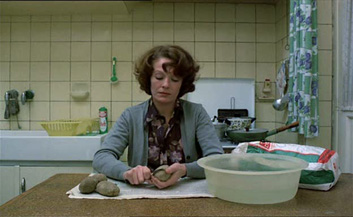Sole Criterion: Jeanne Dielman, 23 quai du Commerce, 1080 Bruxelles
By Brett Ballard-Beach
February 2, 2012
There is method to Akerman’s controlled structuralist “madness” (as well as begging the question as to whether or not Jeanne herself is already or is veering towards a breakdown of her faculties). While it may seem at first that a random sequence of days in one woman’s life has been chosen, the extended takes and time spent on Jeanne’s daily, rigorously controlled and planned routine, allow us to begin to see all the ways in which that system is collapsing in on itself. It calls to mind any of Kubrick’s films in which a perfectly “designed” structure (a nuclear family, the system to prevent a doomsday scenario, a trip through space, a Marine training camp) is undone from the inside, typically by human error, failing, or madness. For all the control Jeanne exerts, all the detachment she appears to exhibit, she is ultimately at the whim of her routine as much as she is its master. When the cracks appear, they quickly lead to rupture.
The initial fissures aren’t so noticeable - a verbal gaffe from Wednesday’s client on his way out, Jeanne forgetting to turn out the light in one room before making her way to the next. But they culminate in the sequence that is at the heart of Akerman’s story, very near the halfway mark, a moment as droll and ridiculous as it is terrifying and tragic. Through some unfathomable (re: ordinary and human) error, she has overcooked the potatoes for the evening’s dinner. And in Seyrig’s exquisite pantomime, we observe that Jeanne has absolutely no clue what to do next. Her reaction - carrying the pot distractedly from room to room before finally making the decision to dump the water in the sink and toss the potatoes could be sped up only slightly and played for slapstick laughs. Akerman astutely observes both the absurdity and the melancholy in Jeanne’s situation.
Akerman’s cinematographer Babette Mangolte faced several unenviable tasks in filming Jeanne Dielman, primary of which was finding a way to keep a film with close to two dozen long takes, very few cuts within individual scenes and only a handful of locations visually stimulating. I attribute whatever warm feeling I get from the apartment scenes to her skill in lighting to avoid sterility. The camera is often kept low (perhaps in deference to its director) so that in some instances there’s a subliminal feeling of Jeanne’s world closing in on or toppling over upon her.
By far the boldest decisions by Akerman and Mangolte are to have no close-ups, no reverse angle shots, and no point-of-view shots. Any one of those, even deployed sparingly, would help the audience into Jeanne’s world (and Seyrig’s process) even if just for a moment by filling the frame with her countenance or serving as a proxy so we can truly “see” what she is looking at, and by extension, gain insight into what she is thinking. Consider it anti-3D: Akerman refuses to meet the audience even halfway with the image, let alone send it shooting out over us, thereby forcing us to move ourselves closer to the image, perhaps physically, but psychically as well.
Another ironic contradiction: hiring an internationally acclaimed actress such as Seyrig, setting her in the heart of domestic drudgery (but with meticulously coiffed hair) and keeping her at a distance from the viewer for the length of the film. Seyrig does an incredible job of internalizing Jeanne’s feelings as needed, and letting us share in the maddening scenes of time creeping along that occurs in the film’s final third when Jeanne’s routine is upset yet again by rising too early, thereby throwing off her timing entirely for her regimented day. The tension that accumulates throughout the day culminates in a finale that offers different levels of release (an orgasm, an act of violence, sitting alone in a darkened living room) but the film resolutely refuses to end by explaining anything, as Akerman remains true to her heroine’s enigma-wrapped-in-a-riddle qualities.
And if there is one defining image, for me, of Seyrig as Jeanne, it is in the look on her face as Thursday’s gentleman client lies on top of her (for once, the camera enters the bedroom) and they silently have intercourse. She has an orgasm and her face and posture encapsulate the gamut of emotions: ecstasy, terror, loathing, and panic. It is possible this may be her first ever orgasm. We can see this play of emotions, but what does she really think about it? About her life? Her family? We are presented with a film’s worth of clue and left to the devices of our own interpretations.
Akerman dodged and circumvented numerous pitfalls with Jeanne Dielman, not the least of which was resisting the temptation to settle for bullying and telling the audience how to feel. Her film is feminist in spirit and production but isn’t simply a tract on the woes of a single mother. It’s experimental in the extreme, but with a star performance at its center capturing a character who, at her core, wouldn’t be out of place in a sudsy Douglas Sirk melodrama from the ‘50s. Every detail feels precise and planned (but not fussed over) yet the film’s emotional plot unravels so spectacularly it feels as if improvisation could take over and anything could happen. And at the end, I come back to the title. Her name is Jeanne Dielman, she lives in Belgium, at this particular address. Of that, at least, I can be confident.
Next time: A Beach Boy. Sweet Baby James. Miles and miles of open road. The defining film of the 1970s car culture genre. DVD Spine # 414.
Continued:
1
2
3




